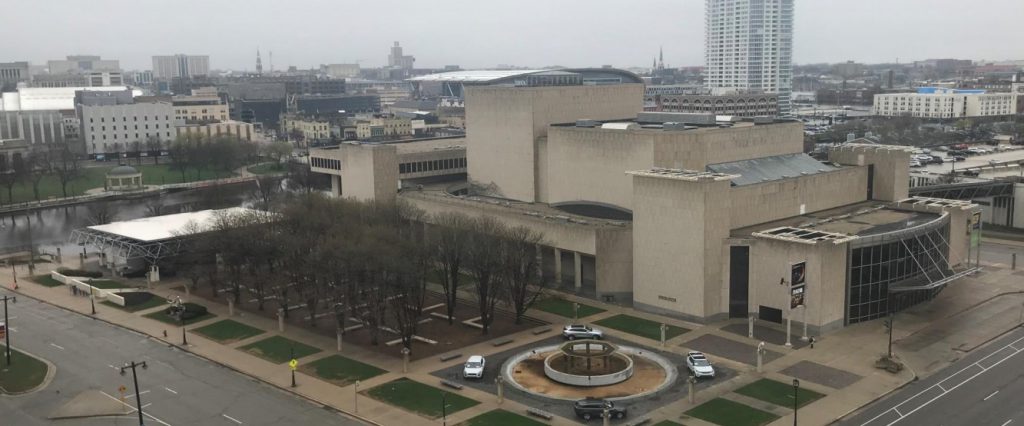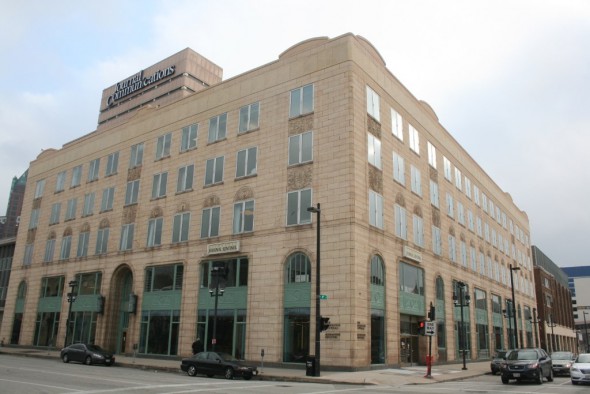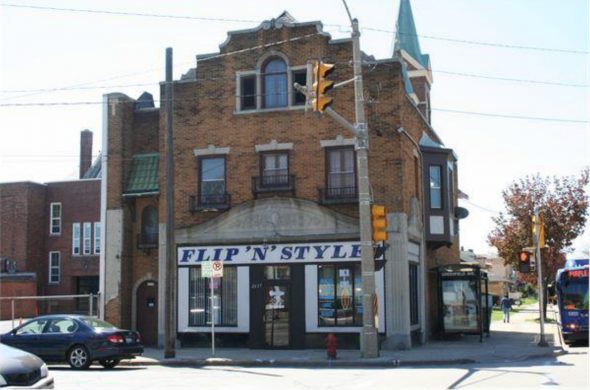Too Much Historic Preservation?
City now has 180 designated sites. Often this has nothing to do with preservation.
Take a drive through downtown Milwaukee, and you’ll notice iconic landmarks that have contributed to the city’s rich history. Such as the Historic Pabst Brewery — the first major brewing company to take root in Milwaukee in 1844. Or Turner Hall — the 1882-built ornate ballroom designed by German American architect Henry C. Koch. Or City Hall, also designed by Koch and the world’s tallest inhabited structure in the 1890s.
There’s no doubt those sites are historic, but what about the Marcus Center for the Performing Arts, built just 50 years ago and already remodeled multiple times?
Or a former pharmacy on the city’s south side that most recently housed a beauty salon?
Or a house in Madison that not all that long ago was owned by a former politician who helped enact gay rights legislation?
Are those sites uniquely historic? Culturally significant enough to be indefinitely protected from any external changes or demolition?
There are now some 180 places on the list of locally historic districts, sites or structures in Milwaukee alone, and that number is rapidly growing. So are questions about whether the push for such designations is driven by agendas that have less to do with history than latter-day politics, less to do with cultural or architectural significance than opposition to what ought to be free-market transactions or private property rights.
How historic preservation works
While the impacts of local historic designations are far-reaching, the process is fairly simple.
Any resident can nominate a site or structure that he or she believes is of historic, architectural or cultural significance. In Milwaukee, for example, nominators submit applications describing the property and why they believe it is significant along with a $25 fee (aldermen are exempt from the fee).
The nomination then is presented to the Historic Preservation Commission, a seven-member panel often composed primarily of unelected citizens appointed by the mayor. The commission defines “historic” as “the attributes of a district, site or structure that possess integrity of location, design, settings, materials, workmanship and association.”
If the site meets at least one of the 10 broad criteria, the application is approved and sent to the Common Council for a final vote. (See list of 10 criteria at the end of article.)
Once a property is designated as historic, it cannot be exteriorly altered or demolished without the commission’s approval. This is true all around the state.
In other words, when homeowners in historic districts want to replace certain windows, install a new roof or add a porch, they must obtain approval from a small government body that decides if the changes are “sympathetic to the historic character of the property.” The same goes for businesses that wish to expand or add on to a historic building.
What often happens, though, is preservation commissions deny the property owners’ requests in order to block specific, likely unpopular, development plans.
Prudent or ridiculous?
In 2015, state Rep. Scott Allen (R-Waukesha), chair of the Assembly Committee on Community Development, co-authored a bill to address the issue.
His legislation, which became law, requires local governments to notify property owners who would be affected by a proposed historic designation and to hold public hearings before new properties or neighborhoods are designated. If owners oppose the designation, they can appeal to a local governing body. However, a majority vote of the body is needed for a reversal.
“There is certainly value in historic preservation, but just because something is old doesn’t mean it’s good,” Allen says. “When are historic designations prudent? And when are we getting ridiculous? We need engaged citizens to bring common sense to the table.”
The Apartment Association of South Central Wisconsin hears complaints from a wide array of Wisconsinites about the problem, says spokesperson Nancy Jensen.
“The (historic designation) statutes are well-intended, but they’re often misused,” she says. “Whether it’s a large developer, a smaller property owner or a farmer, they’re all having the same problems with trying to do renovations to their properties and running into a group of unelected individuals who stop them from doing what they want to their own property.”
“We’re seeing some rather wealthy commissioners who are misusing these statutes to overrule what property owners actually want to do,” she adds.
Journal Sentinel building
In most cases, property owners are not the ones nominating their buildings for historic designation.
For instance, in February, Ald. Bob Bauman — the one elected official on Milwaukee’s Historic Preservation Commission — and Ald. Michael Murphy nominated the Journal Sentinel building at 333 W. State St. The commission approved the designation in March.
In recent years, potential buyers have expressed interest in the building, but it was not until Digital First Media began a hostile takeover bid for Gannett Co. Inc. — owner of the Milwaukee Journal Sentinel and its building — that historic designation was considered. Digital First Media has a reputation for expediting the demise of newspapers and selling off the buildings.
The official rationale for the nomination included the 1924 building’s architect, Frank D. Chase, the simple “design and form” of the building and the fact that it housed “the most successful and influential newspaper in Milwaukee and Wisconsin.”
But Bauman, who represents downtown, admits that he nominated the building in response to the takeover bid. The report presented by commission staff was equally forthright about the motivation.
There’s nothing necessarily improper about trying to save a historically significant building from the wrecking ball. However, the purpose of historic designation is to preserve history — not to prevent a specific property transaction or development plan.
In the case of the Journal Sentinel building, there was a very public discussion of the Milwaukee Bucks’ apparent interest in razing the building for the new arena that eventually was built just down the street — a project with broad political support. At that time, no one nominated the building for historic designation.
Earlier this year, Gannett reportedly entered a purchase agreement with developers Interstate Development Partners LLC and J. Jeffers & Co. And before that, in 2017, there was another preliminary deal to buy the building, which fell through. Neither of those potential sales spurred a historic designation effort.
Bauman told the Badger Institute in an email: “The current buyer — a partnership of two local developers who have developed several historic properties in Milwaukee — is comfortable with historic designation.”
Marcus Center for the Performing Arts
Meanwhile, another downtown site, the Marcus Center for the Performing Arts, became embroiled in a historic preservation dispute over a grove of 36 horse chestnut trees designed by Dan Kiley.
The nonprofit center, built in 1969 at 929 N. Water St., unveiled plans in December to revamp its campus, which called for removal of the trees. In response, two landscape architects nominated the center for historic designation in January.
On April 1, the Historic Preservation Commission approved the designation but granted permission to cut down four failing trees in the grove, with the stipulation that they be replaced within a year with the same type of tree. Soon after the commission’s vote, the center cut down the four trees.
Reasons cited for the designation include the location, which “was symbolic of Milwaukee’s renewed optimism with regard to the arts” after World War II and the Korean War, its “Brutalist/Formalist style,” the “significant modernists” who designed the building and landscape, and the “site in the heart of” downtown.
The Marcus Center, in arguing against the designation, pointed to the center’s 11 major renovations, which it said voided the site’s historic integrity. The center has stated repeatedly that the designation greatly affects its redevelopment plan. Residents also have voiced concerns, citing the need for the center to adapt and grow.
The Milwaukee Common Council this week overturned the historic designation for the Marcus Center with several members dissenting and approved the historic designation for the Journal Sentinel building with no discussion.
Notre Dame School of Milwaukee
These historic designations are hardly the first to derail development or override a property owner’s plans.
When Notre Dame School of Milwaukee, 1418 S. Layton Blvd., sought to demolish a vacant commercial building it purchased as part of an expansion plan, it was barred from doing so when the Historic Preservation Commission granted historic designation — right before demolition was to take place.
The commission cited the building’s architectural characteristics (the “use of stone, brick and stucco, twisted columns or colonnettes, tile inserts, iron balconets, tile roofs and shaped parapets” common in Mediterranean Revival-style buildings) and its unique location (on “a prominent corner of two busy traffic arterials”).
An area resident nominated the building after learning of the school’s demolition plans.
“It was a very frustrating experience,” says school President Patrick Landry. “The building was not historic when we purchased it (in 2016), or we wouldn’t have spent the $150,000 to buy it.”
For many years, the building, built in 1896 and remodeled in 1931, was a local pharmacy. It later housed a tax service, a copying service and, most recently, a hair salon. The school had intended to build a playground in the space but now plans to gut the building and use it for storage.
“There are bullet holes through the glass, so using the space for educational purposes is really not an option,” Landry says.
“To be honest, it felt like the odds were stacked against us,” he adds. “For some reason, this random building meant something to them.”
The same year, the commission granted historic designation to the Historic White House Tavern in the Bay View neighborhood — a restaurant that was vacant for years — after a development group sought to add a patio. The developers insisted they would preserve the history of the 1890 building, at 2900 S. Kinnickinnic Ave., and would only allow a tenant with the same priorities.
The commission cited the tavern’s Queen Anne style, the fact that it had been a gathering place for politicians for years and its location “at a bend of Kinnickinnic Ave.”
Clarenbach house in Madison
Historic designations stymie developments outside of Milwaukee as well. In Madison, the city’s Landmarks Commission is considering the historic designation of a house at 123 W. Gilman St. near Capitol Square, where some of the state’s first LGBT legislators and activists had lived and gathered.
The former residents include the first openly gay elected official in Wisconsin (Madison Ald. Jim Yeadon), a former Dane County supervisor (Lynn Haanen) and, most notably, former state Rep. David Clarenbach, who lived in the house while he helped to pass the Gay Rights Bill of 1982 — the first of its kind in the country. Preservation supporters say the 1886 house also served as a place where LGBT activists discussed strategies, politics and legislation.
Since 1989, Steve Brown Apartments has owned the house and considered building apartments there. But shortly after its plans were announced, a local historian filed an application for historic designation in late 2017.
“Our understanding of historic preservation is a little bit more in-depth,” says Margaret Watson, CEO of Steve Brown Apartments. “But we also respect Clarenbach and support his work, which is why we’re willing to donate the house and move it at our own expense within the historic district.”
However, Watson says, her company has not heard back from the Landmarks Commission in about a year.
“We’ve found that it is becoming more mainstream for people to weaponize the (historic designation) ordinance to obstruct development,” she says. “How is it that anyone walking down the street can submit an application for your property? It’s a bit of an injustice that owners are not involved more in these decisions.”
Jensen, of the Apartment Association, agrees. “What it really comes down to is that (the preservation advocates) don’t want development on the lot,” she says.
State and national registries
Not all forms of historic preservation come with such strict guidelines. In fact, the state and national registries are both “honorary” programs, meaning that property owners do not need government approval to make changes to the properties.
There are over 90,000 properties on the National Register of Historic Places, which says it is the “official list” of the nation’s historic sites. In Wisconsin, there are about 2,500 historic state and/or national properties. Unless there are tax credits attached to the sites, owners do not need permission to make changes to their properties.
That’s why, as many affected by these decisions have argued, so many local historic preservation commissions are used to protect properties through historic designation.
A policy solution?
Jensen and Watson say they’d like to see reintroduced in this legislative session a measure similar to one that was stripped from Allen’s bill in 2015. The provision offered more protection to property owners in the form of an essential veto: If owners oppose the designation or if two-thirds of property owners oppose the designation of a historic district that includes their homes, the designation would not pass.
“People serious about historic preservation need to have everyone at the table for these discussions,” Watson says. “But property owners — those taking on the most risk from these decisions — aren’t part of the conversation on the front end, and that’s a problem.”
“What we really want is owner consent,” Jensen says. “We live in a democracy, so it’s shocking that little commissions of unelected people can make decisions that affect so many people across the state.”
This oped was originally published by the Badger Institute.
Julie Grace is a policy analyst for the Badger Institute.
The criteria for historic designation in Milwaukee
The 10 considerations used by Milwaukee’s Historic Preservation Commission to determine if a site is historic are:
- Its exemplification and development of the cultural, economic, social or historic heritage of the city, state of Wisconsin or the United States.
- Its location as a site of a significant event.
- Its identification with a person or persons who significantly contributed to the culture and development of the city.
- Its portrayal of the environment of a group of people in an era of history characterized by a distinctive architectural style.
- Its embodiment of distinguishing characteristics of an architectural type of specimen.
- Its identification as the work of an artist, architect, craftsman or master builder whose individual works have influenced the development of the city.
- Its embodiment of innovation in architectural design or engineering, pre- or post-World War II, expressed in design, details, materials craftsmanship, construction techniques or function of one or more buildings or structures.
- Its relationship to other distinctive areas which are eligible for preservation according to a plan based on a historic, cultural or architectural motif.
- Its unique location as a singular physical characteristic which represents an established and familiar visual feature of a neighborhood, community or city.
- Its association with a pre-European settlement.
Political Contributions Tracker
Displaying political contributions between people mentioned in this story. Learn more.
Op-Ed
-
Wisconsin Candidates Decry Money in Politics, Plan to Raise Tons of It
 Dec 15th, 2025 by Ruth Conniff
Dec 15th, 2025 by Ruth Conniff
-
Trump Left Contraceptives to Rot; Women Pay the Price
 Dec 8th, 2025 by Dr. Shefaali Sharma
Dec 8th, 2025 by Dr. Shefaali Sharma
-
Why the Common Council’s Amended Budget is Good Policy for Milwaukee
 Nov 20th, 2025 by Alds. Marina Dimitrijevic and Russell W. Stamper, II
Nov 20th, 2025 by Alds. Marina Dimitrijevic and Russell W. Stamper, II






















